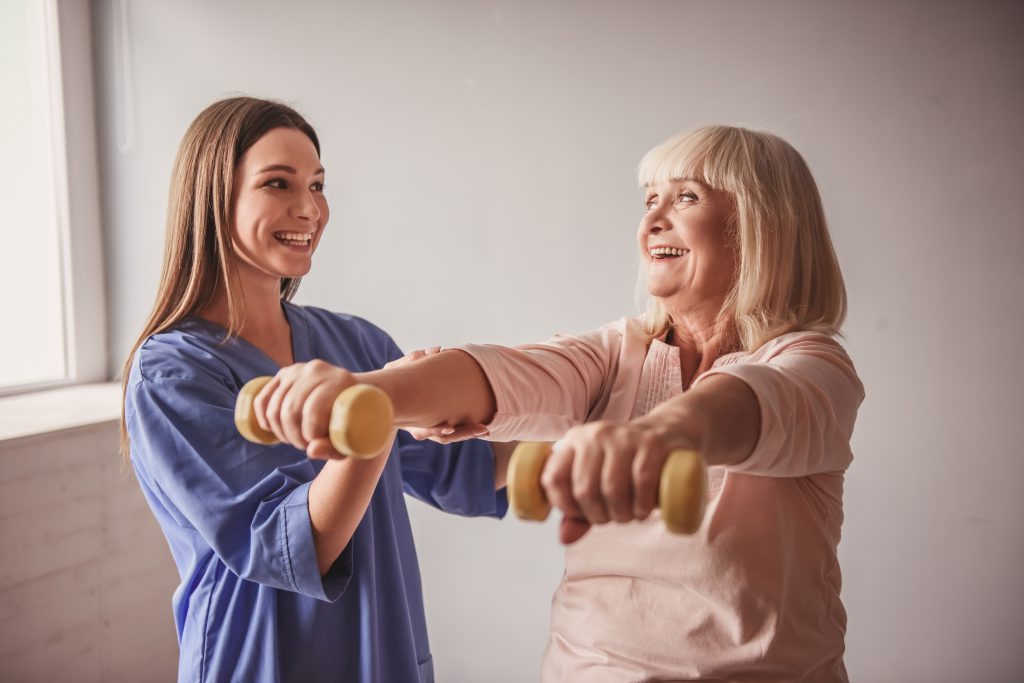October is National Physical Therapy Month! This observance was created by the American Physical Therapy Association, “to educate consumers about the unique benefits of physical therapy treatments.”
In light of this, here are a few notes about physical therapy you maybe haven’t considered before.
It’s not just for sudden injuries.
There are a variety of chronic issues—many of which affect seniors—that can be eased with physical therapy.
• Arthritis
• Osteoarthritis
• Parkinson’s
• Alzheimer’s
• Diabetes
• Vertigo
• Incontinence
• Cerebral Palsy
• Any physical pain in the body
• Multiple Sclerosis
• Stroke recovery
It can also be used for preventative measures.
As people grow older, many experience mobility issues and joint pain. Those with arthritis may be prescribed pain medications from their doctors, as well as drugs that can better increase the lubrication in their joints to ease the chronic aches. Medicine isn’t the only option though, and many seniors choose to partake in physical therapy to help them manage pain and better heal.
Additional potential benefits of physical therapy…
Improve balance
It is common for seniors to experience balance issues. Inner ear problems and medications’ side effects can lead to dizziness and vertigo. If your senior loved one has balance issues, consider talking with his or her doctor to change a prescription kind or dosage to see if it helps. Light physical therapy can also help them learn how to balance better.
Post-surgical assistance
Physical therapy is an important piece of the healing process! Hip injuries are common among seniors, and may lead to surgery. After an operation, most physicians recommend that seniors go through physical therapy to relearn how to walk with their new hips. Physical therapy can help people go from the initial healing stage of lying in bed to sitting upright, wheeling around in a wheelchair, and eventually walking with the help of a walker. Physical therapy is geared toward slow progress that helps seniors heal while still pushing themselves to learn their new limits. Without the helpful encouragement of physical therapists who know just how to get seniors going, some would never be independently mobile after surgery. If your senior friend or family member is heading in to an operation like hip surgery, be sure to talk with his or her doctor about post-surgical care, including physical therapy. Many senior living communities offer this physical therapy in-house.
Increased Endurance
Physical therapy can people regain their strength after muscle loss, and increase their physical endurance for an overall better quality of life.
Reduced risk of:
• Falls
• Infection
• Additional pain

By skipping physical therapy, seniors become more prone to the dangers listed above. In fact, falls are one of the main reasons seniors require physical therapy.
Physical therapy is about easing pain, improving blood circulation, and helping the body heal. It can also help increase a person’s confidence that he or she can regain independence post-surgery or while dealing with chronic health conditions.
The length of the physical therapy treatment process varies from person to person. Physicians can work with therapists to establish treatment plans and monitor progress, making adjustments and improvements as needed.
Different types of physical therapy
Seniorliving.org breaks down the variety of therapy modalities:
• Manual therapy is when the therapist uses his or her hands in an attempt to relax the patient, reduce their pain, and increase flexibility. This modality includes:
– Massaging muscles to relax the patient, improve circulation, and relieve pain.
– Mobilization, which utilizes slow movements to put joints and bones back into place. This can help to loosen tight joint tissues and increase flexibility.
– Manipulation, composed of quick, forceful movements to relieve pain and realign joints and bones.
• Cold therapy utilizes ice packs to help relieve pain, swelling, and inflammation from various conditions, especially arthritis.
• Heat therapy: On the opposite end of the spectrum, heat relaxes muscles and improves blood circulation. In turn, this helps loosen stiff joints from osteoarthritis or other immobilizing conditions.
• Hydrotherapy uses water to treat diseases, increase blood flow, and promote relaxation so the body can heal.
• Electrical stimulation uses electrical current to reduce pain and contract muscles in arthritis sufferers and people in stroke recovery.
• Ultrasound reduces muscles spasms and relaxes muscles using high-pitched sound waves.
Ultimately, physical therapy can greatly improve the quality of life for seniors, which in turn gives families some peace of mind. Consulate Health Care knows that “every moment matters,” and physical therapy forms a major piece of making each one count.
Learn what Consulate Health Care’s network of providers can offer, and find a care center location near you.
If you found an error, highlight it and press Shift + Enter or click here to inform us.


